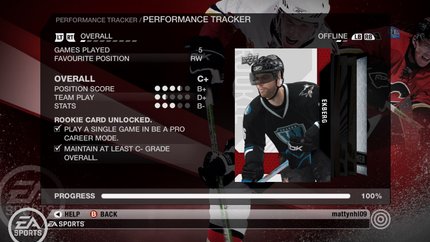

Yes that's right, earning, as opposed to boosting, win-trading or whatever else people like to call the form of cheating that is commonly used to secure the game's precious attribute points.
Here at Operation Sports, we assume that our audience is above cheating; that they, like us, embark down the path for the legend card with the expectation that the journey itself -- the stories gathered from overtime victories, dominating shutouts and thrilling come-from-behind victories -- will be worth more than any amount of superficial "experience points."
To obtain your legend card, you first have to acquire each of the game's previous cards.
These cards can be obtained by reaching certain "games played" milestones while also maintaining a required overall player rating:
Rookie Card (+3 attribute points)
Pro Card (+4 attribute points)
Veteran Card (+4 attribute points)
Superstar Card (+4 attribute points)
Legend Card (+5 attribute points)
Which Position To Play?
While it is certainly possible to maintain an A- overall rating from any of the five skating positions, some are undoubtedly easier to score high marks in than others.
A defenseman, for instance, should earn an easy A for positioning and team play just about every game, provided that he is locking down his portion of the ice, dumping the puck out of the zone whenever possible and keeping a close eye on his turnovers.
Centers also have an excellent chance of scoring two easy A grades per game by roaming the interior of the ice, winning a high percentage of their faceoffs and maintaining a high pass-completion percentage.

Wingers definitely require the most skill to maintain high grades simply because they cannot boost their team play ratings by doing simple things like winning faceoffs or clearing pucks. Instead, they have to rely on the riskier loose-puck dekes to get that extra team play boost. Even the positioning grade is harder for wingers to maintain because the game often penalizes wingers for filling open lanes simply because they are not on "their side" of the ice.
Positioning
Maintaining an A for a player’s position rating is as easy as following the direction of the blue arrow whenever it pops up on screen to indicate that the player is (allegedly) out of position.
I say "allegedly" because forwards will often find that the best spacing actually runs contrary to what the blue arrow is indicating on screen. However, if a player is simply playing the game to secure a high position rating, it is best to follow the blue arrow at all times regardless of how wrong it might occasionally be.
Team Play
Here is where things start to get complicated. Rather than mull over each individual action that can influence a player’s team play rating, simply refer to this list of positives and negatives to figure out what can increase or decrease a player’s cumulative team play score in a given game:
Positives
+ Winning faceoffs
+ Completing passes
+ Calling for good passes
+ Taking "good shots" (generally, those that are taken from high percentage areas, and those that end up finding the net)
+ Successful loose-puck dekes (performed with the left bumper + right stick)
+ Clearing the puck out of the defensive zone (anytime, not just on power plays)
+ Starting "good fights" (usually right after your team has gone down two or more goals)
+ Creating screened goals

Negatives
- Losing faceoffs
- Turnovers
- Calling for bad passes (those that lead to turnovers)
- Taking penalties
- Causing an offside penalty
- Unsuccessful loose-puck dekes
- Causing screened goals (the announcers will usually call you out during the replay)
- Being out of position during an allowed goal (see above)
Stats
This is another fairly easy category to explain since the rating is simply determined by a few key areas:
Club or OTP games?
Of course, even if a player knows what he needs to do on the ice to maintain a high rating, sometimes his opponents are simply so good that it is next to impossible for the player and his teammates to have a good game -- whether it be on the scoreboard or on the stat sheet.
For that reason, it seems that it is often easier to maintain high marks in OTP (online team play) community games, as opposed to the more competitive EASHL (EA Sports Hockey League) club games.
In community games there is a higher chance of getting to play in full six vs. six matchups. These are great for creating high scoring, "everybody wins" type games because most human players (especially the human goalies) commit more mistakes than the game's A.I. players.
So there you have it NHL 09 fans. You have had all season long to get your required number of games in (150), so now is the time to make that final push and get those grades up to the all-important "A-" overall rating.
The reward, while small in terms of attribute points, is something that I think you will find well worth it because of the many great moments that the "chase for the legend card" often leads to in the NHL 09 online arena.



